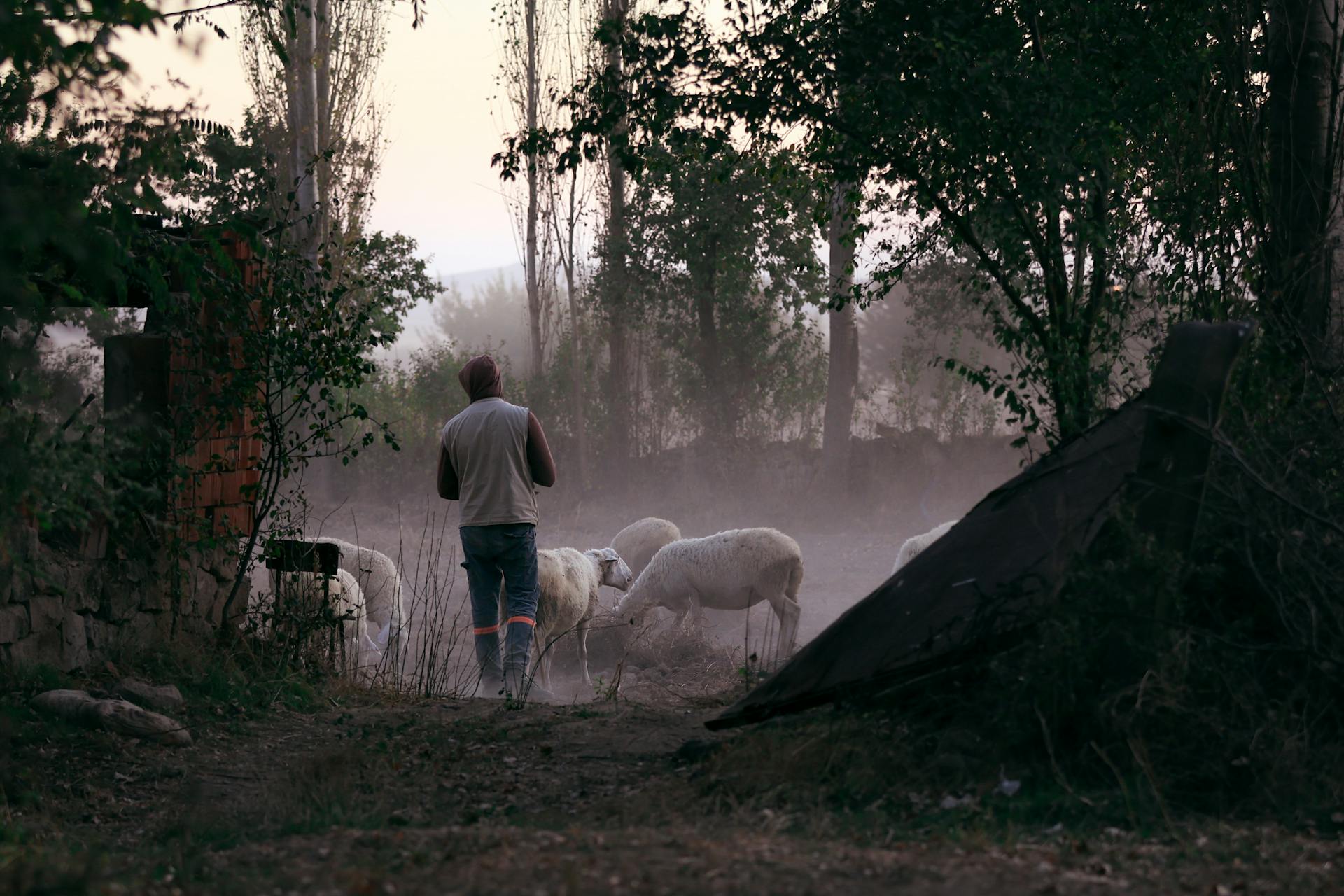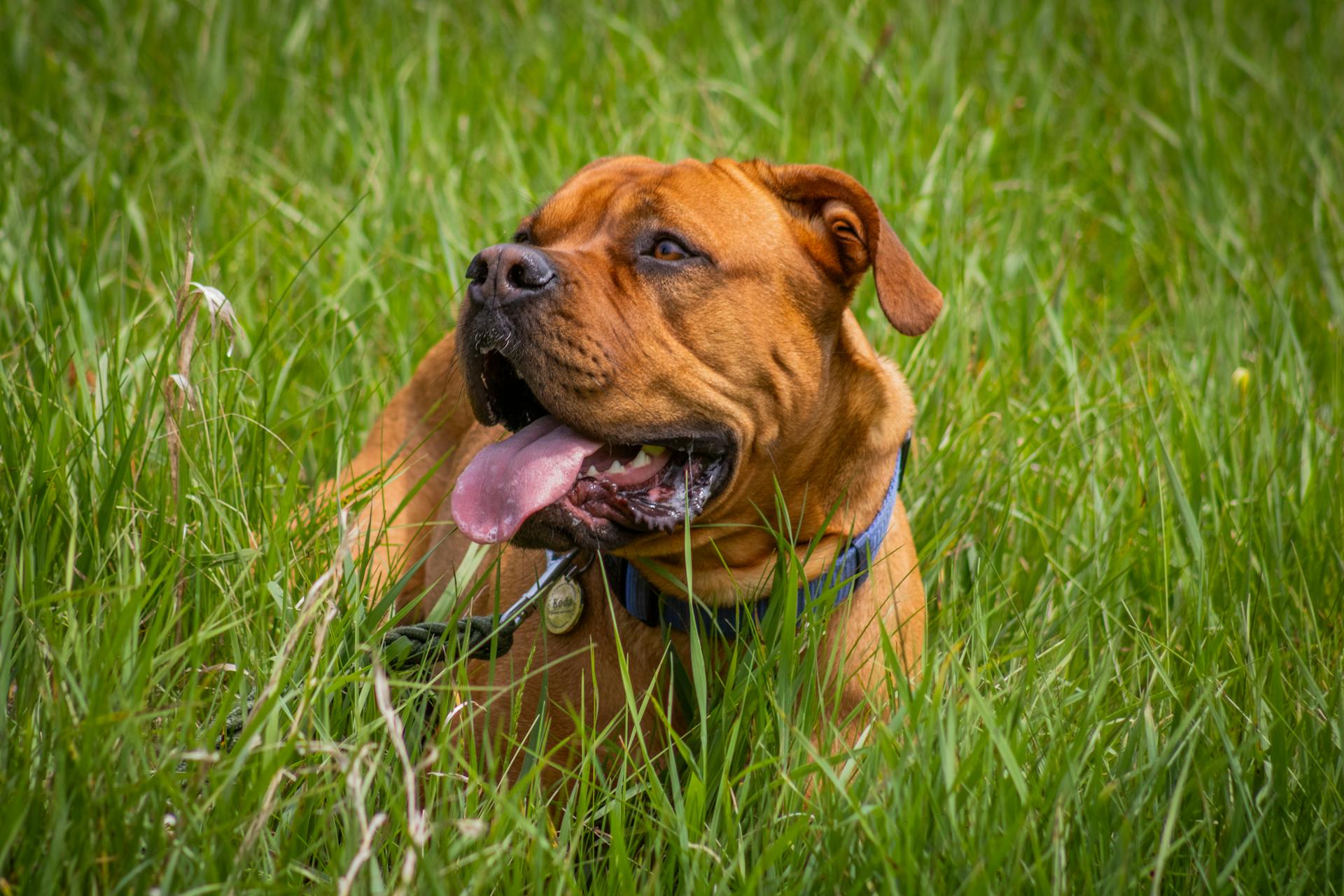
Owning a Pyrenean Shepherd can be a truly rewarding experience. They are highly intelligent dogs that thrive on mental and physical stimulation.
Their high energy levels mean they require regular exercise, ideally at least 2 hours a day, to keep them happy and healthy.
With proper training, Pyrenean Shepherds can learn to obey commands and behave well in public. They are highly trainable due to their strong herding instinct and desire to please their owners.
Pyrenean Shepherds are generally healthy dogs, but they can be prone to certain health issues such as hip dysplasia and eye problems. Regular veterinary check-ups can help identify any potential issues early on.
Consider reading: Pyrenean Shepherd Puppies
History and Origins
The Pyrenean Shepherd has a rich history that dates back to the Pyrenees Mountains along the border between France and Spain. They originated from the ancient herding line of the Pyrenees, named for their native home in the Pyrenees Mountain Range.
The breed was used by shepherds in the Pyrenees to herd and guard livestock, particularly sheep, and this relationship is still going strong today. They were also used as couriers and search and rescue dogs during World War I.
The first Pyrenean Shepherds in the United States were likely introduced as contract herders with the Western Range Association in the 1940s. The breed wasn't recognized by the AKC until 2009.
Here are some key facts about the breed's history:
- Recognized by the French Kennel Club in 1926
- First introduced to the United States in the 1940s
- Recognized by the AKC in 2009
The breed's incredible energy reserve and intelligent disposition set them apart as exceptional flock herding dogs. They were often used in tandem with Great Pyrenees, with the Great Pyrenees guarding flocks and the Pyrenean Shepherds moving them.
Traits and Characteristics
The Pyrenean Shepherd is a high-energy breed that requires regular exercise and mental stimulation to prevent boredom and destructive behavior. They need at least a few walks a day, and they'll thrive with activities like canine sports, advanced training, and herding lessons.
Their temperament is sharp, spunky, and clever, making them a great fit for active families with children. However, they can be bossy when their herding instincts kick in, so it's essential to socialize them well and provide plenty of positive reinforcement training.
Here are some key characteristics of the Pyrenean Shepherd:
Coat Characteristics
The Pyrenean Shepherd's coat is a defining feature of the breed, and it's essential to understand its characteristics to care for these dogs properly. The coat can be either rough-faced or smooth-faced, and both varieties have unique characteristics.
The Rough-Faced Pyrenean Shepherd has a harsh, long, or demi-long coat that's flat or slightly wavy. This coat type is halfway between the hair of a goat and a sheep's wool. On the other hand, the Smooth-Faced variety has a shorter, softer coat with short, fine hairs on the muzzle that become longer on the sides of the head and finish with a modest ruff.
The coat length and texture of the Pyrenean Shepherd vary depending on the variety, with the Rough-Faced having a longer coat than the Smooth-Faced. The Smooth-Faced variety has a clean coat around the head and ears, helping to distinguish its facial features more clearly.
The Pyrenean Shepherd's coat can come in various shades of fawn, from tan to copper, with or without a mixture of black hairs; gray, ranging from charcoal to silver to pearl gray; merle of diverse tones; brindle; black; and black with markings that are not to exceed 30 percent of the body surface.
Intriguing read: Pyrenean Sheepdog Smooth-faced

Here's a summary of the coat types and characteristics of the Pyrenean Shepherd:
Regular grooming is essential to help manage shedding, especially in the Rough-Faced variety, which tends to shed more than the Smooth-Faced. Brushing can minimize shedding, but it's not a guarantee, and some Pyrenean Shepherds may require more frequent brushing during seasonal changes.
Characteristics
The Pyrenean Shepherd is a breed that's always on the go, with an energetic and playful personality that pairs well with active families. They need vigorous exercise and mental stimulation, or they'll get bored and restless.
Their intelligence is one of their best assets, making them highly trainable, but also prone to getting creative with disobedience when left alone. With the right amount of activity, they're loving and protective companions.
Here's a breakdown of their characteristics:
As a breed that thrives on activity, they're perfect for families who love the outdoors and want a companion that can keep up with their adventures.
Tail
The Pyrenean Shepherd's tail is a notable feature, which can be naturally long or docked. A natural bobtail is common.
The tail is set rather low as an extension of the croup. It's an important part of the dog's overall appearance and functionality.
The long tail typically reaches the hocks and tapers to a fine point. This is a distinctive characteristic of the breed.
In motion or excitement, the tail may be carried higher than the topline but should never curl over the back. This helps the dog maintain its balance and agility.
Docked and bob-tailed dogs are utilized with equal measure for the difficult tasks required of them. This shows that the tail is not essential for the dog's ability to work.
Behavior and Training
Pyrenean Shepherds are highly intelligent and respond well to training, especially when it's done with positive reinforcement. They love to learn and please their owners, making them a joy to train with.
Their intelligence and eagerness to please make them a great breed for dog sports and activities, such as Agility, Herding Trials, and Obedience Trials. These activities not only provide mental and physical stimulation but also strengthen the bond between the dog and its owner.
To manage excessive barking, considerate training and proper socialization from a young age can help. However, potential owners should be prepared for a dog that is naturally inclined to make some noise.
Here are some dog sports and activities that are well-suited for Pyrenean Shepherds:
- Agility: A timed obstacle course that tests a dog's agility, balance, and speed.
- Herding Trials: A great way to channel the breed's natural instincts.
- Obedience Trials: Reinforces the human-canine bond by improving a dog's responsiveness to commands.
- Flyball: A relay race that involves teams of dogs jumping over hurdles to reach a spring-loaded box.
- Rally Obedience: A sport where the dog and handler complete a course designed by a judge.
- Tracking: Leverages the breed's keen sense of smell to track scents over various surfaces.
- Search and Rescue: With proper training, Pyrenean Shepherds can excel in Search and Rescue missions.
- Conformation: A dog show where breeders and owners showcase their dogs and see how well they conform to the Breed Standard.
- Therapy Work: The Pyr Shep's gentle and affectionate nature makes it a good candidate for Therapy Work.
- Hiking and Outdoor Adventures: A great way to burn off excess energy and strengthen the bond between the dog and its owner.
Behavior
Pyrenean Shepherds are intelligent dogs that respond well to training, particularly when using positive reinforcement methods such as clicker training and treats. They thrive on mental stimulation and can become bored if left alone for extended periods.
These dogs are naturally protective and may bark at strangers or other animals, but proper socialization from an early age can help manage this behavior. They also have a strong will and can be independent, making consistent training and handling essential.
Consider reading: Dutch Shepherd Training
Pyrenean Shepherds are high-energy dogs that require regular exercise and mental stimulation to prevent boredom and destructive behaviors. They excel in dog sports such as agility, herding trials, and obedience trials, which can help channel their energy and intelligence into positive outlets.
In terms of their temperament, Pyrenean Shepherds can be reserved around new people and may require time to warm up to strangers. However, they are loyal and protective of their families and make excellent watchdogs.
A key aspect of training Pyrenean Shepherds is providing mental stimulation and engaging activities to prevent boredom and destructive behaviors. Here are some tips to consider:
- Provide regular exercise and mental stimulation through activities such as agility training, herding trials, and obedience trials.
- Use positive reinforcement training methods such as clicker training and treats to encourage desirable behavior.
- Provide interactive toys and puzzles to keep your Pyrenean Shepherd's mind engaged.
- Consider enrolling your dog in dog sports or activities that challenge their intelligence and energy.
By following these tips and providing consistent training and handling, you can help your Pyrenean Shepherd become a well-behaved and loyal companion.
Puppies
Pyrenean Shepherd puppies are a joyful and exciting responsibility. Each little bundle of energy is an intelligent and curious creature that is eager to explore the world.
They require consistent training and socialization from the start to help them grow up to become well-behaved and balanced adults. Early exposure to different people, places, and situations will help in developing their confidence and adaptability.
Puppies of this breed are high-energy, so they need plenty of exercise and mental stimulation. Providing a variety of toys and engaging in interactive play will contribute to their mental and physical development.
It's essential to establish a routine for feeding, potty breaks, and exercise to help the pup adjust to its new home. A balanced and age-appropriate diet is vital for the puppy's growth and development.
Regular veterinary check-ups are crucial to monitor the puppy's health and keep it up to date on vaccinations and preventive care. As with all breeds, early training and socialization are key, and positive reinforcement training methods will yield the best results.
Providing ample exercise and mental stimulation is paramount for this energetic and intelligent breed. With enough playtime and engaging activities, the puppy will be happy and well-adjusted.
Related reading: Maremma Sheepdog Puppy
Dog Grooming
Pyrenean Shepherds require regular grooming to keep their coats looking their best. Brush them at least once a week to prevent mats and tangles, especially for the rough-faced variety with its longer hair.
A pin brush is ideal for removing dead undercoat and reducing shedding. Regular nail trims, ear cleanings, and a dental care routine that includes at-home teeth brushing and professional cleanings are also essential.
The frequency of bathing depends on the dog's activity level, but it's generally best to bathe them as needed. Brushing their teeth seven days a week is ideal, but weekly brushings still help prevent dental disease.
Pyrenean Shepherds need consistent daily exercise to keep them happy and healthy. Grooming sessions also serve as a bonding experience between the dog and its groomer.
Here are the essential grooming requirements for Pyrenean Shepherds:
- Weekly brushing
- Occasional bathing
- Routine ear cleaning
- Periodic nail trimming
- Regular tooth brushing
Brushing can minimize shedding, especially during seasonal changes. The rough-faced variety typically sheds more than the smooth-faced variety, but regular grooming can help manage shedding and keep the coat in good condition.
Health and Nutrition
Pyrenean Shepherds are generally a healthy breed, but like all dogs, they can be prone to certain health issues.
Their lifespan is one of their most notable advantages, with many living long and healthy lives.
A proper diet and lifestyle can go a long way in minimizing the risk of common health problems such as hip dysplasia, elbow dysplasia, epilepsy, progressive retinal atrophy, and obesity.
To ensure your Pyrenean Shepherd stays healthy, it's essential to feed them a high-quality dog food that's suitable for their life stage, whether they're a puppy, adult, or senior.
A good rule of thumb is to limit treats to no more than 10 percent of their daily calories to avoid overfeeding.
Here are some common health problems that can affect Pyrenean Shepherds:
- Hip dysplasia
- Elbow dysplasia
- Epilepsy
- Progressive retinal atrophy
- Obesity
Nutrition
Nutrition is a crucial aspect of a Pyrenean Shepherd's health, and feeding them the right food can make all the difference. A high-quality dog food that's appropriate for their life stage is essential.
To determine the right food for your Pyrenean Shepherd, consider a diet formulated for active breeds. This will ensure they get the nutrients they need to stay healthy and energetic.
Puppies, in particular, require a diet rich in proteins and essential nutrients to support their rapid growth and high energy levels. As they mature into adults, their dietary needs change, and it's essential to adjust their food intake accordingly.
Adult Pyrenean Shepherds generally require around 1 to 2 cups of high-quality dry kibble per day, split into two meals. However, these amounts can vary significantly based on the dog's size, age, metabolism, and activity level.
It's also essential to monitor your Pyrenean Shepherd's weight and adjust their food portions as necessary. If they appear to be gaining weight, they may need smaller food portions and more exercise. Conversely, if they're underweight or lack energy, they may need an increase in food.
To avoid overfeeding your Pyrenean Shepherd, limit treats to no more than 10 percent of their daily calories. Table scraps are also best avoided, especially foods that can be toxic to dogs.
Here's an interesting read: Dutch Shepherd Weight
Here's a rough guide to the daily food intake for Pyrenean Shepherds:
Remember, every dog is unique, and what works for one may not work for another. Paying close attention to your Pyrenean Shepherd's body condition and adjusting their food intake as needed will help keep them healthy and happy.
Genetic Conditions
Pyrenean Shepherds are generally healthy dogs, but like all breeds, they can be prone to certain genetic conditions. They can live long lives, even into their late teens, but it's essential to be aware of the potential health issues.
Hip dysplasia is a common condition associated with this breed, caused by a malformation in the joints as they grow. Severe cases may require corrective surgery.
Progressive Retinal Atrophy (PRA) affects the retina in your dog's eyes, impairing their vision and eventually causing blindness. This condition is a concern for Pyrenean Shepherds.
Epilepsy is a neurological disorder that causes seizures in dogs. Mild to moderate cases can usually be treated with medication.
Curious to learn more? Check out: Pyrenean Mastiff Dog
Obesity is another common health problem in Pyrenean Shepherds, which can be minimized through a healthy lifestyle and proper diet.
Here are some common health problems associated with the breed:
It's essential to work with a responsible breeder who provides comprehensive information about the dog's medical history and known bloodline. If you're rescuing a Pyrenean Shepherd, it's best to have initial testing performed by your veterinarian to ensure your pup is healthy and fit.
Frequently Asked Questions
What was the Pyrenean Shepherd originally used for?
The Pyrenean Shepherd was originally used for herding and protecting flocks of sheep and goats in the Pyrenees Mountains. This versatile breed also served as messengers, guards, and rescue dogs during times of need.
What is the life expectancy of a Pyrenean Shepherd?
Pyrenean Shepherds typically live for 15 years with minimal health issues. With proper care, they can enjoy a long and healthy life.
Are Pyrenean Shepherds rare?
Pyrenean Shepherds are relatively rare outside of France, but gaining popularity in other countries. They are a unique and charming breed worth learning more about.
What are some fun facts about Pyrenean shepherds?
Pyrenean Shepherds have a rich history dating back to 6000 BC, originating in the Pyrenees Mountains of France where they've been herding and protecting livestock for thousands of years. They even played a role in World War I as messengers, guards, and rescue dogs
Sources
- https://www.embracepetinsurance.com/dog-breeds/pyrenean-shepherd
- https://www.wisdompanel.com/en-us/dog-breeds/pyrenean-shepherd
- https://www.thesprucepets.com/pyrenean-shepherd-full-profile-history-and-care-4707630
- https://dogacademy.org/breeds/pyrenean-shepherd
- https://showsightmagazine.com/dog-breeds/pyrenean-shepherd/
Featured Images: pexels.com


